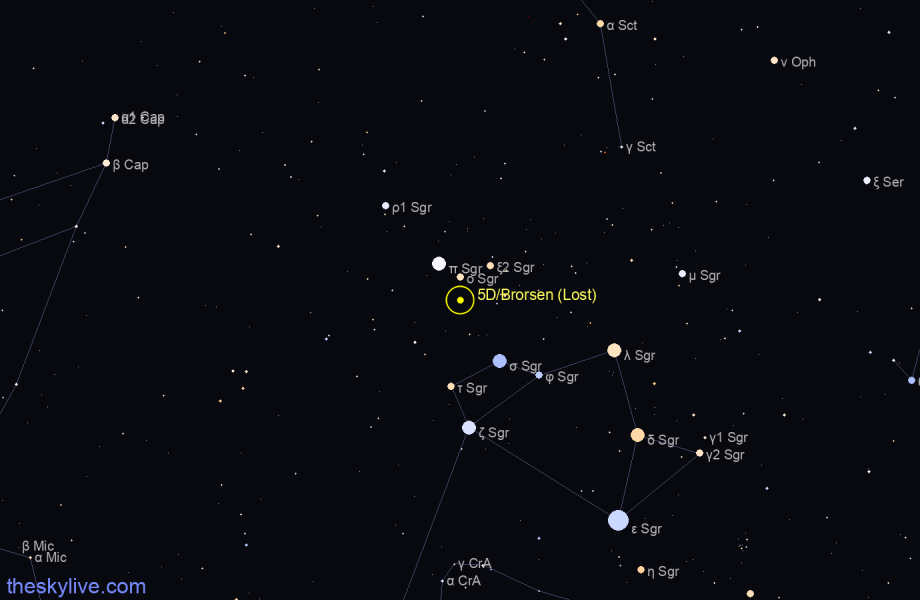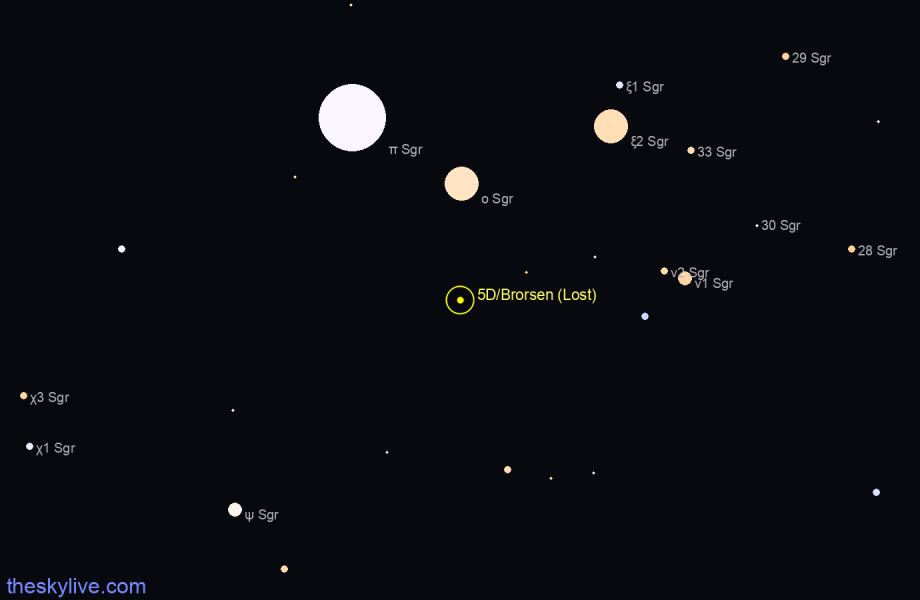5D/Brorsen (Lost)
Comet 5D/Brorsen, also known as Comet Brorsen, was a periodic comet belonging to the Jupiter family of comets, which is now considered a lost comet. It was first discovered by the Danish astronomer Theodor Brorsen on February 26, 1846. Based on the collected observations, the comet had an orbital period of 5.46 years and traveled around the Sun in an eccentric orbit with the closest approach to the Sun (perihelion) at a distance of about 0.58 astronomical units (AU), and the farthest distance (aphelion) at around 5.6 AU. The latest successful observations of Comet 5D/Brorsen were conducted during the 1879 apparition, while it was not possible to find the comet again during any of the subsequent apparitions.
5D/Brorsen (Lost) is currently in the constellation of Sagittarius, at a distance of 572,545,093 kilometers from Earth.
View interactive star map
The observed values of Magnitude, Coma Diameter and Tail Length are derived from the most recent observation recorded at the Comet Observers Database. The value of Predicted Magnitude comes from the JPL Horizons ephemerides service and, in the case of comets, might be inaccurate given the highly dynamic and unpredictable behavior of these objects. When available, please refer to the Observed Magnitude value and consider the Predicted Magnitude as a directional indication. We acknowledge with thanks the comet observations from the COBS Comet Observation Database contributed by observers worldwide and used in this table to report recent comet observations.
Today's rise, transit and set times of 5D/Brorsen (Lost) from Greenwich, United Kingdom (all times relative to the local timezone Europe/London):
- 5D/Brorsen (Lost) is above the horizon from Greenwich, United Kingdom .
- Right now it is placed in the South direction at an altitude of 16° above the horizon.
- Given its current magnitude, 5D/Brorsen (Lost) is visible only through long exposure photography.
- Go to interactive sky chart
If you need to access this information frequently for your observations, you can create a simple customized Quick Access page, so that you can easily bookmark it in your browser favorites or add a shortcut to your mobile phones' home screen.
5D/Brorsen (Lost) Position and Finder Charts
Field of view: 10x6 degrees
View fullscreen
Higher precision deep sky finder chart, 60 arcmin wide, showing where 5D/Brorsen (Lost) is right now. Click on the image to see a more detailed fullscreen tracker view.
Also check out Where is 5D/Brorsen (Lost)?, a page that provides all the information needed to find 5D/Brorsen (Lost) in the sky and additional links to sky charts.
5D/Brorsen (Lost) Distance from Earth
The distance of 5D/Brorsen (Lost) from Earth is currently 572,545,093 kilometers, equivalent to 3.827228 Astronomical Units. Light takes 31 minutes and 49.8049 seconds to travel from 5D/Brorsen (Lost) and arrive to us.
The following chart shows the distance of 5D/Brorsen (Lost) from Earth as a function of time. In the chart the distance data is measured in Astronomical Units and sampled with an interval of 1 day.
The value of the reported distance might be somewhat inaccurate around the times of closest approach for objects passing extremely close to Earth. The value of the distance of 5D/Brorsen (Lost) from Earth is also available as a real time updated value in the Live Position and Data Tracker.
Closest Approach of 5D/Brorsen (Lost) to Earth
Between 1 January 2013 and 30 December 2100, the closest approach of 5D/Brorsen (Lost) to Earth happens on Tue Oct 26 2083 at a distance of 0.259836 Astronomical Units, or 38,870,982 kilometers:
NOTE: values for the closest approach are computed with a sampling interval of 1 day.
5D/Brorsen (Lost) Brightness and Light Curve
The following chart is the predicted light curve (visual magnitude as a function of time) of 5D/Brorsen (Lost), according to the most recent ephemerides data. Magnitude data is sampled with a 2 days interval and there might be inaccuracies for objects changing brightness very rapidly during the course of a few days. For comets there could be large discrepancies between the observed and predicted brightness because of their highly dynamic behaviour.
5D/Brorsen (Lost) Orbital Elements
The following table lists the orbital elements of 5D/Brorsen (Lost) at epoch 01 January 1970 00:00 UTC (JD: 2407440.5). Source: JPL Small-Body Database
| Element | Symbol | Value |
|---|---|---|
| Orbit eccentricity | e | 0.80979600 |
| Orbit inclination | i | 29.38210000° |
| Perihelion distance | q | 0.58984700 AU 88,239,855 km |
| Aphelion distance | Q |
5.61240952 AU 839,604,516 km |
| Semi-major axis | a |
3.10112826 AU 463,922,186 km |
| Orbital period | period |
5.4612 years 1,994.7020 days |
| Date of perihelion transit | Tp | 1879-Mar-31 00:49:06 2,407,439.5341 JD |
| Next perihelion transit | 1884-Sep-14 17:39 2,409,434.2361 JD |
|
| Argument of perihelion | peri | 14.9468° |
| Longitude of the ascending node | node | 102.9676° |
| Mean anomaly | M | 0.17432378482129° |
| Mean motion | n | 0.18047809°/day |
Visualization of 5D/Brorsen (Lost) Orbit
This 3d orbit diagram is a feature of our 3D Solar System Simulator and shows the orbit of 5D/Brorsen (Lost) with respect of the Sun and the orbits of the major planets. The position of 5D/Brorsen (Lost) and the planets along their orbits in this diagram accurately represents the current configuration of the objects in the Solar System. This is an experimental feature and it requires a WebGL enabled browser. Please provide us feedback!
View 5D/Brorsen (Lost) in the 3D Solar System Simulator
5D/Brorsen (Lost) 15 Days Ephemeris
The following table lists the ephemerides of 5D/Brorsen (Lost) computed for the past and next 7 days, with a 24 hours interval. Click on each row of the table to locate 5D/Brorsen (Lost) in our Online Planetarium at the chosen date.
| Date | Right AscensionR.A. | DeclinationDec. | MagnitudeMag | Constellation |
|---|---|---|---|---|
| 2024 Apr 21 | 19h 14m 20s | -22° 11’ 27” | 17.55 | Sagittarius |
| 2024 Apr 22 | 19h 14m 15s | -22° 12’ 43” | 17.55 | Sagittarius |
| 2024 Apr 23 | 19h 14m 08s | -22° 14’ 00” | 17.55 | Sagittarius |
| 2024 Apr 24 | 19h 14m 00s | -22° 15’ 20” | 17.55 | Sagittarius |
| 2024 Apr 25 | 19h 13m 51s | -22° 16’ 42” | 17.54 | Sagittarius |
| 2024 Apr 26 | 19h 13m 42s | -22° 18’ 07” | 17.54 | Sagittarius |
| 2024 Apr 27 | 19h 13m 32s | -22° 19’ 35” | 17.54 | Sagittarius |
| 2024 Apr 28 | 19h 13m 19s | -22° 21’ 02” | 17.54 | Sagittarius |
| 2024 Apr 29 | 19h 13m 06s | -22° 22’ 35” | 17.54 | Sagittarius |
| 2024 Apr 30 | 19h 12m 52s | -22° 24’ 07” | 17.54 | Sagittarius |
| 2024 May 01 | 19h 12m 37s | -22° 25’ 42” | 17.54 | Sagittarius |
| 2024 May 02 | 19h 12m 20s | -22° 27’ 20” | 17.54 | Sagittarius |
| 2024 May 03 | 19h 12m 02s | -22° 29’ 00” | 17.54 | Sagittarius |
| 2024 May 04 | 19h 11m 44s | -22° 30’ 42” | 17.54 | Sagittarius |





